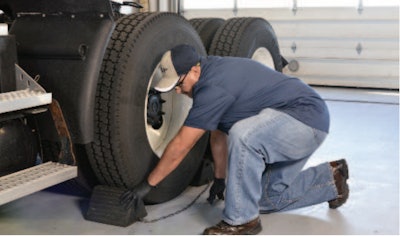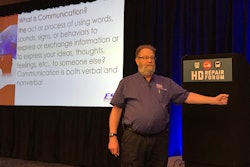

SKF says other vocations, as well as pre-set and unitized wheel ends, are not covered in its new guidelines. Inspection criteria are on two levels: the more frequent in-service or pre-trip inspection and the more detailed inspection.
Level 1: Pre-trip (in-service) inspection.
SKF says these inspections should occur prior to every trip and whenever driver returns to vehicle while in service. Inspection points include:
- Inspect as soon as vehicle is stopped: Feel hubs, taking care not to burn yourself, for excessive heat or variance in temperatures between wheel ends.
- Inspect prior to (re)entering the vehicle:
- Visually inspect each wheel end for loose, damaged or missing fasteners.
- Inspect each hubcap for sufficient lubricant level, missing or loose bolts or plugs.
- Check for leaks by looking for wetness at hubcap gasket, axle flange gasket or seal, hub or brake lining. Wetness at the hubcap plug or hub vent is not an indication of a leak.
If any of the above conditions exist, take appropriate actions, including placing vehicle out of service if need be.
Level 2: Detailed inspection
SKF says these inspections should occur annually or every 100,000 miles, whichever comes first. Inspection points include:
- Conduct all of the inspection criteria listed under level 1.
- For oil-bath, non-driven axles, check lubricant fill level and condition. If lubricant is in good condition but low, fill to proper level using the same lubricant within the wheel end. If lubricant contains contaminants such as water (milky or white appearance) or debris (gritty), replace lubricant with same lubricant type within the wheel end. A magnet may be used to find metal particles.
- For semi-fluid grease, non-driven axles, pull the outer bearing and inspect lubricant level and condition. Use OEM recommended fill level or 3 o’clock /9 o’clock as prescribed by ATA’s Technology & Maintenance Council (TMC). Replace lubricant if contaminants are found as recommended above.
- Lift and support each axle. Rotate wheel, checking for vibration. If rotation is not smooth or a vibration is detected, inspect bearings for wear or damage.
- Check bearing end play with dial indicator. If end play is out of the TMC-recommended range (RP618) .001-.005 inch, inspect bearings for wear or damage.
- Check abnormal or uneven tire wear as this may be an indication bearing need to be replaced.
- Whenever seal is replaced, thoroughly inspect bearings. A leaky seal often precedes or leads to a bearing failure.
- Bearings should be replaced in sets (cup and cone). These are mating components that wear together.
Additionally, SKF says technicians may see the wear characteristics more prevalent on one or the other, but both are affected. Following are examples of conditions where bearings should be replaced:
- Discoloration is an indication of high levels of heat.
- Wear, spalling or pitting at ends of rollers indicate improper bearing adjustment either excessive or too tight.
- Pitting, circular wear of the race indicate contaminants in the lubricant.
- Spalling on the race, a wearing away of the bearing surface, is the result of contamination, improper installation, improper lubrication or the end of normal bearing life.
- Vertical etching on the race indicates moisture contamination of the lubricant.
If one seal is replaced, SKF says it is recommended to check the records when the other wheel seals were last serviced. If they have similar in-service time, it would be economical to replace those also while the vehicle is in the shop. An expensive, non-scheduled service or even road call may be avoided.
For more information on recommended services for SKF’s family of Automotive and Heavy Duty products, please CLICK HERE. Technical Tips are provided under both the Automotive and Heavy Duty sections on the website, SKF says.











